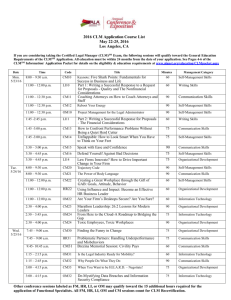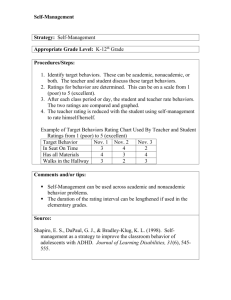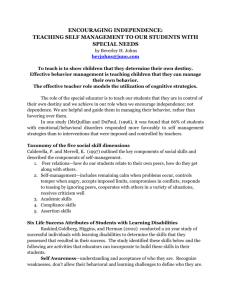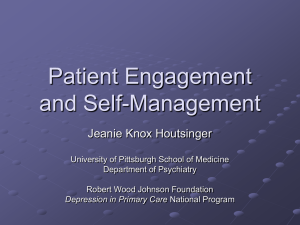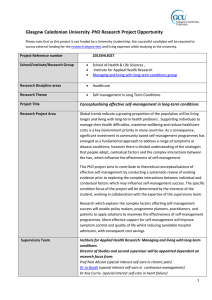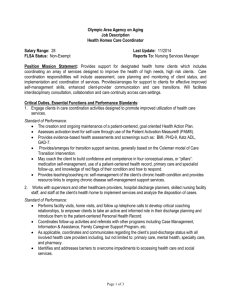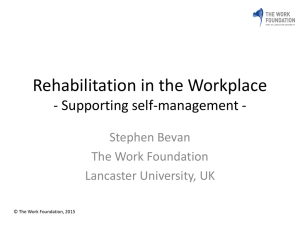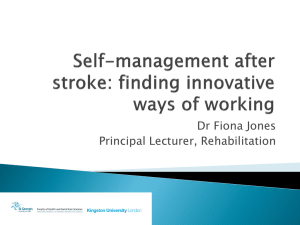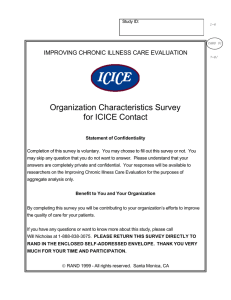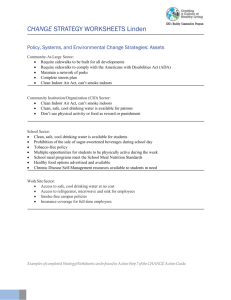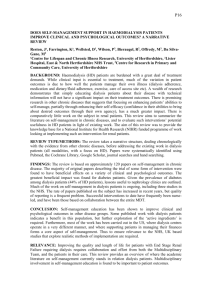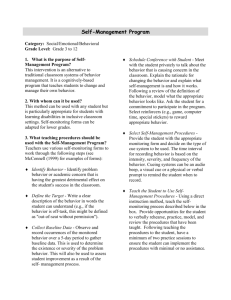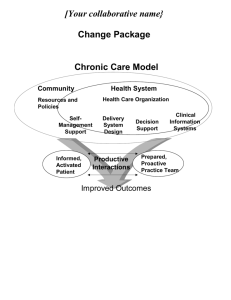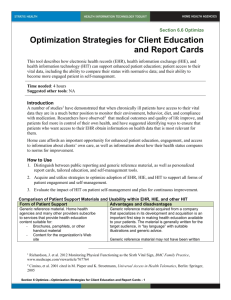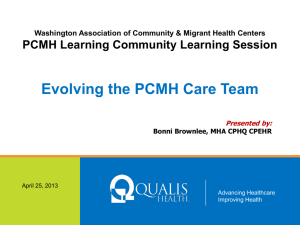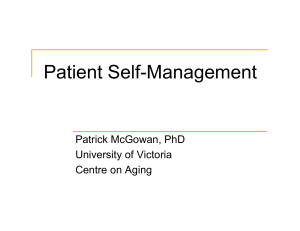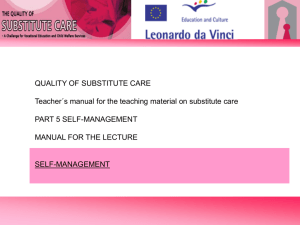Understanding Goal Setting Action Planning
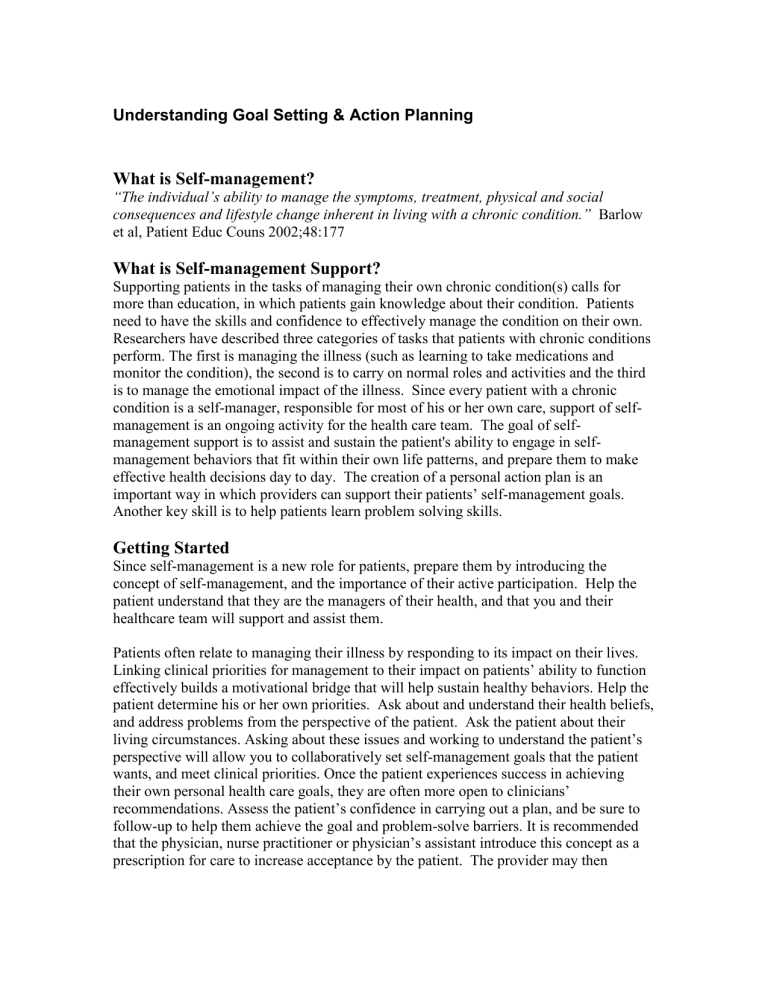
Understanding Goal Setting & Action Planning
What is Self-management?
“The individual’s ability to manage the symptoms, treatment, physical and social consequences and lifestyle change inherent in living with a chronic condition.”
Barlow et al, Patient Educ Couns 2002;48:177
What is Self-management Support?
Supporting patients in the tasks of managing their own chronic condition(s) calls for more than education, in which patients gain knowledge about their condition. Patients need to have the skills and confidence to effectively manage the condition on their own.
Researchers have described three categories of tasks that patients with chronic conditions perform. The first is managing the illness (such as learning to take medications and monitor the condition), the second is to carry on normal roles and activities and the third is to manage the emotional impact of the illness. Since every patient with a chronic condition is a self-manager, responsible for most of his or her own care, support of selfmanagement is an ongoing activity for the health care team. The goal of selfmanagement support is to assist and sustain the patient's ability to engage in selfmanagement behaviors that fit within their own life patterns, and prepare them to make effective health decisions day to day. The creation of a personal action plan is an important way in which providers can support their patients’ self-management goals.
Another key skill is to help patients learn problem solving skills.
Getting Started
Since self-management is a new role for patients, prepare them by introducing the concept of self-management, and the importance of their active participation. Help the patient understand that they are the managers of their health, and that you and their healthcare team will support and assist them.
Patients often relate to managing their illness by responding to its impact on their lives.
Linking clinical priorities for management to their impact on patients’ ability to function effectively builds a motivational bridge that will help sustain healthy behaviors. Help the patient determine his or her own priorities. Ask about and understand their health beliefs, and address problems from the perspective of the patient. Ask the patient about their living circumstances. Asking about these issues and working to understand the patient’s perspective will allow you to collaboratively set self-management goals that the patient wants, and meet clinical priorities. Once the patient experiences success in achieving their own personal health care goals, they are often more open to clinicians’ recommendations. Assess the patient’s confidence in carrying out a plan, and be sure to follow-up to help them achieve the goal and problem-solve barriers. It is recommended that the physician, nurse practitioner or physician’s assistant introduce this concept as a prescription for care to increase acceptance by the patient. The provider may then
introduce the patient to another team member who can help the patient develop a specific action plan to achieve the goal, document the plan, and arrange for follow up.
Collect data about goals set and achieved to be used in the next visit. The patient encounter form from the registry or a structured encounter form of your making is critical to successful data capture. Make sure these data are entered in the registry or are easily accessible for use at the next visit.
Agree on when and how you and patient will follow-up on the self-management goals that were set, and write this in the patient plan. Agree on an interval between planned visits based on clinical need and patient preference. Make sure follow-up to all clinical and self-management task is part of your daily practice of care and that the patient receives a copy of the plan.
Making a specific Action Plan
The plan should contain all of the following steps:
Exactly what are you going to do?
How will you eat less, how far will you walk, what meditative technique will you practice?
How much will you do?
Will you walk 2 blocks walk for 20 minutes, not eat between meals for 2 days, practice yoga for 10 minutes?
When will you do this?
Will you do this before lunch, in the shower, when I arrive home from work?
How often will you do the activity?
It’s important to begin with a frequency that is reasonable, to start slowly and build successes. If they do more, so much the better but the goal is to do the activity often enough to be successful, and yet not feel pressured on a daily basis.
Anticipate barriers.
Help the patient imagine what might get in the way of their plan.
Potential solutions for barriers Ask the patient for ideas that might help them overcome the barriers
Follow-up plan When, where and how you will check in with the patient about their experience with the plan
Confidence rating On a scale of 1-10, with 1 being no confidence that the plan can be completed to 10 being absolutely certain that they can complete the plan, have the patient rate their confidence level.
Tips for Creating a Successful Action Plan
Begin with something the patient wants to do
Make the goal reasonable (something the patient can reasonably expect to be able to accomplish this week)
Strive for a change that is behavior-specific (losing weight is not a behavior; not eating in the evenings while watching television is a behavior)
Ensure that the plan answers these questions: what ; how much ; when (think about the day/the week – which days, what times, etc.); how often ?
Start when the patient has a confidence level of 7 or greater (this is the belief that they can, and will, complete the entire contract)
Goals versus behavior-specific changes
Keep in mind the difference between a healthy change, a goal that is set to reach that change and the behavior required to attain that goal. For example:
Healthy Change: Lose weight
Goal : lose 4 pounds in the next month
Behavior : eating carrots for a snack, not chocolate
Healthy Change: Exercise more
Goal : exercise for 20 minutes twice a week
Behavior : walk to work
Healthy Change: reduce stress levels
Goal : spend 15 minutes a day relaxing
Behavior : listen to meditation tape
Example Action Plan
Name : Joe Smith
Phone: (206) 555-1234
Date: June 22, 2004
The healthy change I want to make is: Start a walking program
My goal for the next month is: To walk three times per week
The steps I will take to achieve my goal are (what, when, where, how much, how often):
I will walk around my neighborhood for 15 minutes, directly after I get home from work on Monday, Wednesday, and Friday.
The things that could make it difficult to achieve my goal include:
My sister may need to talk on the phone after work, and it might be too late to go after we talk.
My plan for overcoming these difficulties includes :
I can ask my sister if she absolutely needs to talk that day. If I have to miss a regular walking time, I can make up that day by driving to the park on the weekend and walk for
15 minutes in the morning, then resume my regular plan the following week.
Support/resources I will need to achieve my goal include:
I need to buy a new pair of sneakers and extra-cushioned socks so that my feet don’t get blisters. I would feel more comfortable walking if I had a dog with me. I can ask my neighbors if I can ‘borrow’ Sparky, their dog.
My confidence level (scale of 1-10, 10 being completely confident that you can
achieve the entire plan.) 8
Review date: June 29, 2004 (in one week) Review method (phone, email, in-person):
In-person
Problem-solving Techniques
Patients need both support and skills to change behavior. It can be helpful to remind patients that change takes time and that small efforts can build to big successes. Hearing a health care provider reiterate that self-management can require persistence, and that success is possible – even when obstacles are encountered - can be just the support a patient needs when the going gets a bit rough. However, many patients have not developed specific skills in solving problems. The following method has been shown to help patients find solutions to problems, and might be offered as a tool.
Identify the problem
Help the patient get to the root of the issue. For example, is it that they have problems maintaining a diet when they eat out, or their family doesn’t understand their wishes to eat a healthier diet?
List ideas to solve the problem
Help the patient come up with many ideas, some they have tried before to some that may seem ridiculous, and to come up with a list of ideas that might work.
Choose one method to try
Out of all the options listed, help the patient choose one, or a combination of ideas that they think will work for them.
Try it for 2 weeks. Encourage patients to give each idea a good trial period to see if it will work.
Evaluate the results
After the patient’s given the idea a fair trial, assess the outcome.
Try another idea if the first one doesn’t work
Have the patient return to their list of ideas and try another.
Locate other resources
Resources can be friends, family, members of their health care team, or a community link such as the public library or a health fair.
Accept that the problem may not be solvable right now
Remind the patient that if the solutions they came up with this time haven’t worked, that it doesn’t mean that other solutions won’t be effective at another time, or that different problems can’t be solved using this solution. Encourage them to keep trying; do your best to foster hope and persistence.
Much of the content above has been adapted from Lorig et al, Living a Healthy Life with Chronic
Conditions. Bull Publishing Company, 2000.
